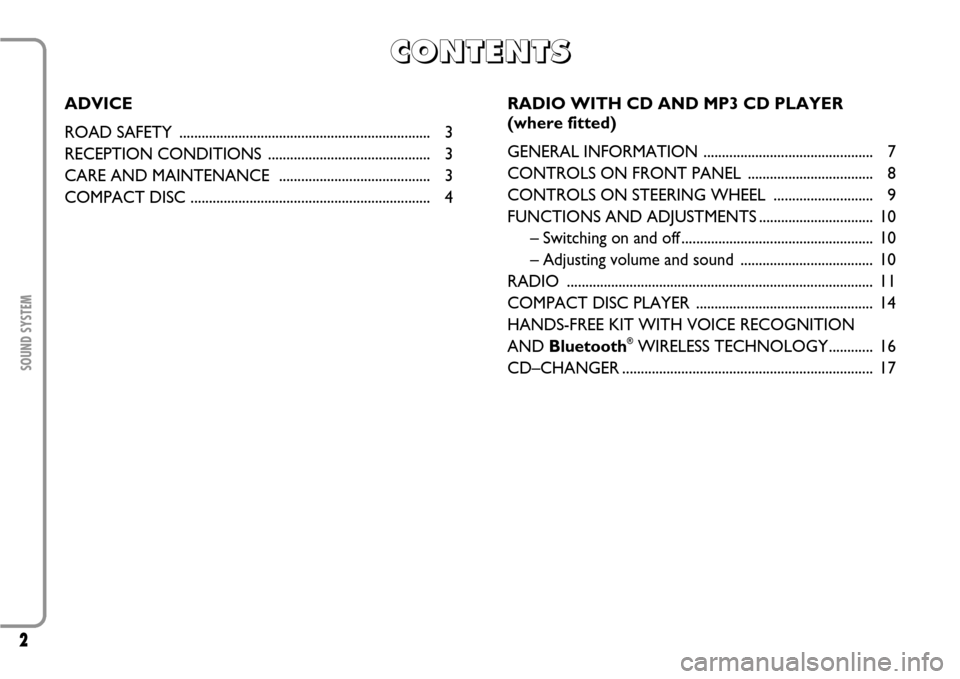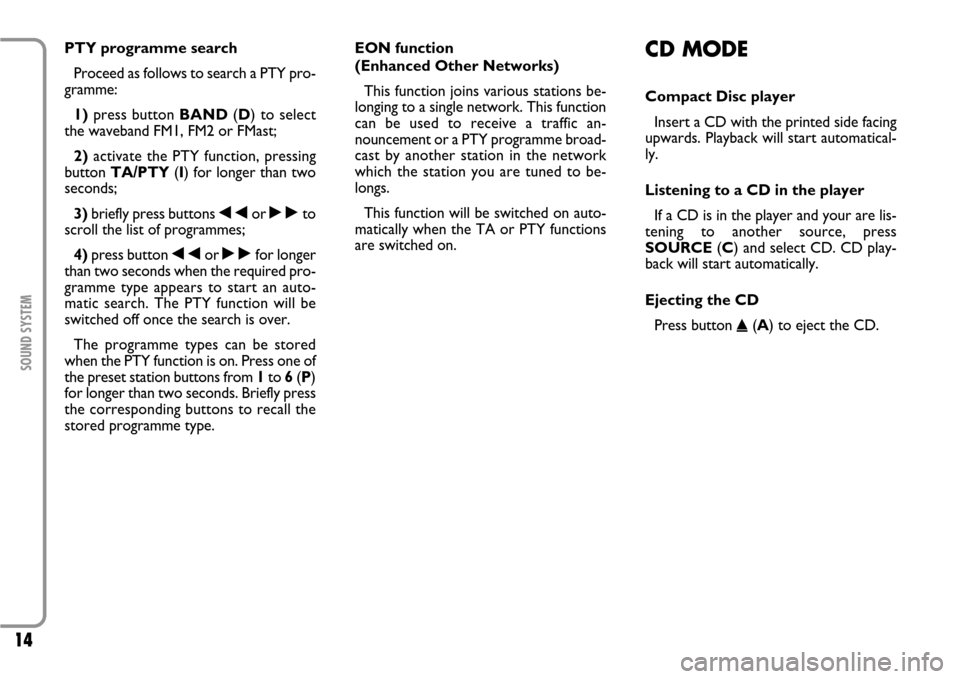Page 3 of 22

2SOUND SYSTEM
C C C C
O O O O
N N N N
T T T T
E E E E
N N N N
T T T T
S S S S
ADVICE
ROAD SAFETY .................................................................... 3
RECEPTION CONDITIONS ............................................ 3
CARE AND MAINTENANCE ......................................... 3
COMPACT DISC................................................................. 4RADIO WITH CD AND MP3 CD PLAYER
(where fitted)
GENERAL INFORMATION .............................................. 7
CONTROLS ON FRONT PANEL .................................. 8
CONTROLS ON STEERING WHEEL........................... 9
FUNCTIONS AND ADJUSTMENTS ...............................10
– Switching on and off ....................................................10
– Adjusting volume and sound .................................... 10
RADIO................................................................................... 11
COMPACT DISC PLAYER................................................ 14
HANDS-FREE KIT WITH VOICE RECOGNITION
AND Bluetooth
®WIRELESS TECHNOLOGY............ 16
CD–CHANGER.................................................................... 17
Page 5 of 22

4SOUND SYSTEM
COMPACT DISC
Remember that dirt or marks on the CD
can cause skipping or bad sound quality
in playback. For optimal playback follow
these practical hints:
– Only use Compact Discs which have
the following brand:
– Carefully clean all Compact Discs of
fingerprints and dust using a soft cloth.
Support Compact Discs from the outer
circumference and clean from the centre
outwards;
– Never use chemical products for clean-
ing (e.g. spray cans, antistatic or thinners)
as they might damage the surface of Com-
pact Discs;– After use, put Compact Discs back in
their container, to avoid marks or scratch-
es that may cause skipping when playing;
– Do not expose Compact Discs to di-
rect sunlight, high temperatures or damp
for prolonged lengths of time to prevent
them from bending;
– Do not stick labels or write on the
recorded surface of Compact Discs with
pens or pencils.
To remove a Compact Disc from its
container, press the centre and raise the
disc carefully, holding it by the outer cir-
cumference.
Always hold Compact Discs by the out-
er circumference. Never touch the sur-
face.To remove fingerprints and dust, use a
soft cloth starting from the centre of the
Compact Disc outwards.
New discs may be rough around the
edges. When these discs are used, the
player might not work or the sound might
skip. To remove the roughness from the
edge of the disc use a ball-point pen, etc. Proper way to hold
the compact disc
Removing the disc No Ball-point pen
Roughness
Page 6 of 22
5SOUND SYSTEM
For best playing use only original CDs.
Proper operation is not guaranteed when
using R/RW CDs not properly mastered
and/or with max. capacity exceeding 650
MB.IMPORTANTShould copy-protected
CDs be used, then, few seconds may be
required for playing them. Moreover, due
to the proliferation of always new and dif-
ferent protection methods, it is not guar-
anteed that the CD player can play what-
ever protected disc. Copy protection is
often indicated on the CD cover in small
letters or hard to read characters. Usu-
ally it is indicated by writings like: “COPY
CONTROL”, “COPY PROTECTED”,
“THIS CD CANNOT BE PLAYED ON A
PC/MAC”, or it is identified by symbols
like:Protected discs (and their cover) very
often are not marked with the audio CD
identification symbol:
IMPORTANTDo not use the protec-
tive sheets for CD in commerce or discs
with stabilisers, etc. as they might get stuck
in the internal mechanism and damage the
disc.
Page 7 of 22
6SOUND SYSTEM
IMPORTANTThe CD player can read
most of the compression systems cur-
rently on sale (e.g.: LAME, BLADE, XING,
FRAUNHOFER) however, due to the
evolution of these systems, reading of all
compression formats is not guaranteed.
IMPORTANTWhen loading a multi-
session CD, only the first session will be
played.
Notes on Compact Discs
Do not stick labels on the surface of the
Compact Disc or write on the surface
with pens or pencils.Do not use solvents like stain removers,
antistatic sprays or thinners in commerce
for cleaning Compact Discs.
Do not use highly scratched, cracked, or
distorted discs, etc. The use of these discs
will involve malfunctioning or damage to
the player.Do not expose Compact Discs to direct
sunlight or any source of heat.No No No No
Page 15 of 22

14
SOUND SYSTEM
PTY programme search
Proceed as follows to search a PTY pro-
gramme:
1)press button BAND(D) to select
the waveband FM1, FM2 or FMast;
2)activate the PTY function, pressing
button TA/PTY(I) for longer than two
seconds;
3)briefly press buttons ÷or ˜to
scroll the list of programmes;
4)press button ÷or ˜for longer
than two seconds when the required pro-
gramme type appears to start an auto-
matic search. The PTY function will be
switched off once the search is over.
The programme types can be stored
when the PTY function is on. Press one of
the preset station buttons from 1to 6(P)
for longer than two seconds. Briefly press
the corresponding buttons to recall the
stored programme type.EON function
(Enhanced Other Networks)
This function joins various stations be-
longing to a single network. This function
can be used to receive a traffic an-
nouncement or a PTY programme broad-
cast by another station in the network
which the station you are tuned to be-
longs.
This function will be switched on auto-
matically when the TA or PTY functions
are switched on.
CD MODECompact Disc player
Insert a CD with the printed side facing
upwards. Playback will start automatical-
ly.
Listening to a CD in the player
If a CD is in the player and your are lis-
tening to another source, press
SOURCE(C) and select CD. CD play-
back will start automatically.
Ejecting the CD
Press button
˚(A) to eject the CD.